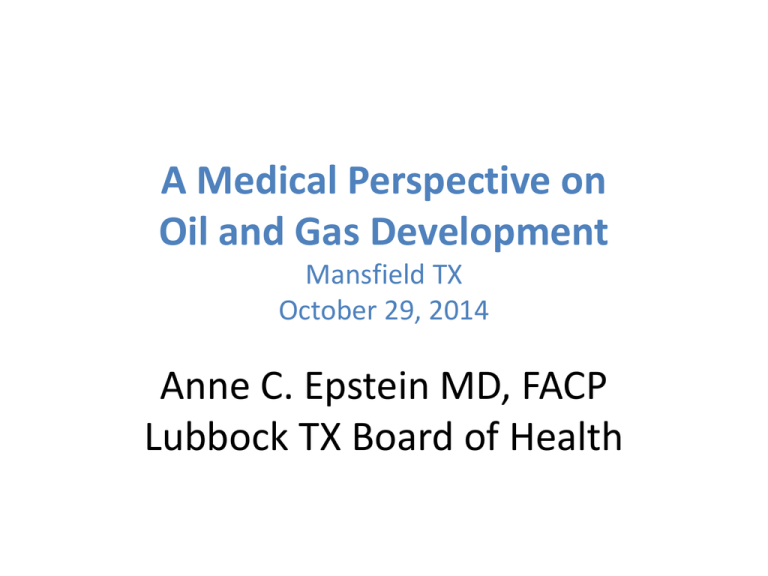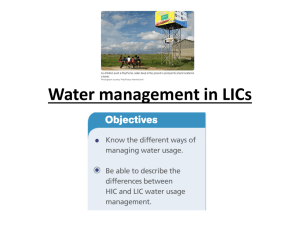Health and Environmental Impacts of Oil and Gas Developement
advertisement

A Medical Perspective on Oil and Gas Development Mansfield TX October 29, 2014 Anne C. Epstein MD, FACP Lubbock TX Board of Health Health Risks of Oil and Gas Development 1. Toxic Air Emissions: Benzene 2. Human Health Impacts Associated with Air Emissions 3. Risk of Groundwater Contamination 4. The Precautionary Principle and Public Health Image credit: Zach Long/Lubbockonline (Seminole) Toxic Air Emissions: Benzene A highly toxic carcinogen that occurs naturally in oil and gas • VOC-volatile organic compound Long-term health effects • Leukemia- a “Group 1 Carcinogen” • Life-threatening anemia • Immune system suppression • Possible fetal abnormalities High levels of exposure • Coma, seizures, irregular heart rhythms, fluid in the lungs, death Children and developing fetuses are more vulnerable to all toxic air emissions ATSDR August 2007, ww.atsdr.cdc.gov/toxicprofiles/tp3.pdf, CDC Emergency Safety and Health Database Paulson, Testimony before House Subcommittee Feb 2014 NIOSH Study of Oil & Gas Worker VOC Exposure August 2014 A flowback technician gauging a flowback tank through a hatch on top of the tank • Measured worker exposure to VOCs at 6 completion sites in Colorado & Wyoming • 15 of 17 benzene samples exceeded the recommended 8 hr exposure limits for workers gauging flowback or production tanks • Benzene exposures were variable, unpredictable, and sometimes very high: – 200 ppm close to open tank hatches- several readings – Recommended 15 min exposure limit: 1 ppm • Conclusions: Benzene levels reached concentrations that potentially pose health risks for workers Esswein et al, J of Occupational and Environmental Hygiene, 11:10, 01 Aug 2014 TCEQ Barnett Shale Study 2009 • 94 monitoring sites surveyed 2009 – Flyover, GasFindIR cameras, VOC monitors • Air samples collected at 73 sites • Benzene was detected above the long term health based comparison value (> 1.4 ppb) at 21 monitoring sites in 12 different areas • 2 sites required immediate action for value > 180 ppb – 1 compressor station:1100 ppb – 1 gas well: 15,000 ppb (5 feet from the well) – Both repaired, came into compliance TCEQ Interoffice Memo Jan 27, 2010, “Health Effects Review of Barnett Shale Formation Area Monitoring Projects” and Sadlier & Honeycutt, “TCEQ Barnett Shale Update” 2010 VOC emissions captured on infrared camera by TCEQ 2009 Heavy VOC emissions captured by infrared camera at Aruba facility in the Barnett Shale Screenshot of a TCEQ video posted by D. Hasemyer, Center for Public Integrity, May 28 2014 Air Toxin Concentrations During Well Completion in Garfield County CO (McKenzie et al, Science of the Total Environment, 22 March 2012) 9 8 7 6 5 4 3 2 1 0 Natural Gas Development Area > 1/2 mile away Well Completion samples 150-500 ft from well pad center during uncontrolled flowback Flyover Air Monitoring in Colorado Airborne measurements of air pollutants – 12 flights in May 2012 Correlated with atmospheric data Results: Benzene emissions were between 7 and 9 times higher than estimated by State of Colorado inventories Petron et al, American Geophysical Union, May 2014 Human Health Impacts Associated with O & G Air Emissions Health Impact Assessment from the Colorado School of Public Health 2012 Measured hazardous air pollutants at different distances from O&G wells Near: 500 feet and less from a well Far: > ½ mile from a well Found elevated levels of hazardous air pollutants near wells : Benzene, Toluene, Ethyl benzene, Xylene (BTEX) Calculated the risk of illness under 2 different scenarios: Subchronic: short term , high intensity- well completions Chronic: long-term , lower intensity- well production McKenzie et al, Science of the Total Environment 22 March, 2012 Non-cancer Hazard Indexes by duration of exposure and distance from Source Adgate , National Academy of Health Workshop, 2012 Hazard indexes by health end point: Near wells, 20 month exposure scenario (Adgate 2012, National Academies of Health, Health Impact Assessment of Shale Gas Extraction: Workshop Summary) Birth Outcomes and Maternal Residential Proximity to Natural Gas Development in Rural Colorado The data: 1996 - 2009 • All birth records in rural Colorado (Rural sites chosen to avoid air pollution from cities) • All hospital and clinic records of birth defects • Records of location and year built for all gas wells in rural Colorado Total 124,842 births • Researchers analyzed level of maternal exposure to gas wells: how far away and how many gas wells at the time of birth • 3 groups: low, medium, and high exposure • Reference group: no gas wells within 10 miles McKenzie et al, Environmental Health Perspectives, 28 January 2014 Birth Outcomes and Maternal Residential Proximity to Natural Gas Development in Rural Colorado McKenzie et al, Environmental Health Perspectives, 28 January 2014 Number of babies born with Congenital Heart Disease Compared to 0 wells w/in 10 miles: 10% increased risk for 1-3 wells/ mile , low exposure (281 births) 20% increased risk for 4-124 wells/ mile, medium exposure (300 births) 30% increased risk for > 125 wells/ mile, high exposure (355 births) Statistical significance p< 0.001 Adjusted for multiple factors Rabinowitz et al (Yale), Environmental Health Perspectives Sept 2014 • Subjects: Randomly chosen, 180 households/ 494 individuals with a private water well in Washington County PA • Exposure: 624 active natural gas wells in Washington County in 2012 • Study: Survey regarding health symptoms Image credit: B. Mark Schmerling (Washington County) Rabinowitz et al, Environmental Health Perspectives Sept 2014 Results Rabinowitz et al, Environmental Health Perspectives Sept 2014 Compared to people living > 2 km from the nearest gas well, People living < 1 km away had a greater incidence of: • Upper respiratory symptoms (39% vs 18%) • Skin symptoms (13% vs 3%) • Average number of reported symptoms (3.3 vs 1.6) Results statistically significant even after adjustment for multiple factors Image from Parr Family, Lisa Parr’s daughter, Emma (published by CNN) TX Confirmed Cancer Cluster in Barnett Shale: Flower Mound TX • Breast Cancer – 369 cases, expected number 303 (2002-2011) – 99% confidence interval statistically significant • Benzene – Possible cause of breast cancer Texas Department of State Health Services, July 30, 2014. Institute of Medicine 2011, “Breast Cancer and the Environment” Image credit: National Cancer Institute Private Drinking Water Wells and Risks due to Groundwater Contamination • 15 million Americans rely on private drinking water wells that use groundwater • Drinking contaminated groundwater can cause human illness • EPA regulations that protect the public water supply do not apply to private wells • Water quality testing is at the owner’s discretion http://www.cdc.gov/healthywater/drinking/pr ivate/wells/ Groundwater Contamination from Oil and Gas Activities in Pennsylvania Reported by the Pennsylvania Dept. of Environmental Protection, August 28, 2014 • 243 cases where “DEP determined that a private water supply was impacted by oil and gas activities” 2008 – 2014 • 1.2 % of the total number of wells Hess, PA Environmental Digest Aug 29, 2014 DEP, Regional Determination Letters, Aug 29 20I4 Image credit: AP Photo/Ralph Wilson Groundwater Contamination from Oil and Gas Development in Texas Reported by the Railroad Commission of Texas • 532 total cases in 2013 • 72 new cases in 2013 – Benzene, other BTEX, Hydrocarbons, crude oil, and other toxins Texas Groundwater Protection Committee, “Joint Groundwater Monitoring and Contamination Report 2013,” April 2014 Groundwater Contamination from Surface Spills in Colorado • 77 spills of oil or produced water reported in 1 year (July 2010-July 2011) that contaminated groundwater • Benzene exceeded maximum contaminant levels in groundwater - 90% • 16% of the spills had not been remediated as of May 2012 • Average spill: 1000 gallons Gross et al, Journal of the Air & Wastewater Management, 20 March 2013, Image credit Lubbockwater.com Casing and Cementing Failures in Pennsylvania 2000-2012 • 41,000 oil and gas wells – After 2009, most were unconventional wells • Data source: state inspection reports (DEP) • Results – Overall structural failure rate = 1.9% – Unconventional wells in drilling boom area failure rate = 9.18% – Each additional inspection prior to 2009 increased the chances of finding a structural failure by 17.7% Ingraffea et al, PNAS May 30, 2014 Graphic by Al Granberg/ProPublica Toxic Effects of Arsenic in Drinking Water Image credit: woodleywonderorks/Flickr • Arsenic : a major public health concern according to the World Health Organization • Colorless and tasteless: may be undetected in drinking well water for many years • Long term exposure effects – Cancer of the skin, bladder, lungs, and possibly of the kidney, liver, and prostate. “Group 1 Carcinogen” – Diabetes, kidney disease, high blood pressure, heart attacks and stroke – Blood cell, liver, and nerve ending damage – Skin thickening and rashes – In pregnant women: spontaneous abortion, stillbirth WHO, “Exposure to Arsenic: a Major Pubic Health Concern” 2010 Arsenic in Private Water Wells in the Barnett Shale, Texas • 100 private water wells sampled – 91 from active area • ( 1 or more gas wells within a 5 km radius) – 4 from non-active area • (no gas wells within a 14 km radius) – 5 from reference site outside the Barnett Shale • (no gas wells within a 60 km radius) • Compared with historical data from 330 private wells from the same area 1989-1999, before gas development Fontenot et al, Environmental Science and Technology 25 July 2013 % of Water Wells with Arsenic/ Selenium Levels Greater than Maximum Contaminant Limits Fontenot et al, J. Environ Sci. Technology, July 31, 2013 35 30 25 20 Historical Non-Active 15 Active 10 5 0 Arsenic Selenium The Precautionary Principle • “When an activity raises threats of harm to the environment or human health, precautionary measures should be taken even if some cause and effect relationships are not fully established scientifically.” – Endorsed by the US Government * – Endorsed by the American Public Health Association as a “cornerstone of preventive public heath policy and practice”** 1998 Wingspread Statement on the Precautionary Principle *in signing the Rio Declaration on Environment and Development in 1992 **American Journal of Public Health 91(3), March 2001, pl. 495






